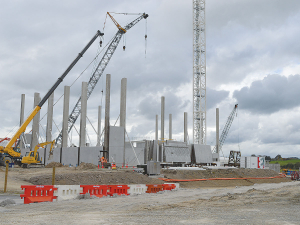Govt to rethink farm health and safety rules with practical reforms
Farmers are welcoming new Government proposals to make farm health and safety rules more practical and grounded in real-world farming.
 Fonterra’s Lichfield plant extension under construction. While most “high risk” industries such as construction and forestry are seeing marked downward trends in annual fatalities, agriculture appears to be static, sadly with another 16 people killed in on-farm accidents in 2018.
Fonterra’s Lichfield plant extension under construction. While most “high risk” industries such as construction and forestry are seeing marked downward trends in annual fatalities, agriculture appears to be static, sadly with another 16 people killed in on-farm accidents in 2018.
Farmers spend many hours planning their lives around the farming year, but often health and safety is left out.
Livestock farmers might plan to calve to meet the spring flush of grass, raising stock for breeding or fattening and figuring when they need to go to the works; and arable farmers typically plan the best time for cultivation and sowing, the timely application of herbicides and the best time to harvest for quality or yield.
It’s strange then, that many of those same farmers still take a she’ll-be-right attitude on health and safety policies on their farms, largely relying on luck for their own and their family’s safety, rather than good management.
While high-risk industries such as construction and forestry are trending down in annual fatalities, farming appears static: 16 people were killed in farm accidents in 2018.
The consequences are widespread in many ways, on personal and business levels. Families are devastated by the loss of loved ones and breadwinners, and businesses suffer loss of morale, loss of productivity and real damage to their reputations.
We must cry ‘enough’, and act decisively to protect our families and staff. This starts with farm owners, managers and key staff leading by example in making changes that workers can embrace and act on.
Being proactive about safety means planning to ensure risks are identified, then actively addressing those risks. Such planning should include regularly maintaining tractors and vehicles, ensuring all safety guards are in place, setting limits to vehicle speeds and requiring the use of helmets and seatbelts.
Given that 11 of the 16 deaths in 2018 involved vehicles — eight were rollovers and three involved machinery — these simple points above could make a huge difference. Research shows that the use of seatbelts alone can reduce driver and front seat passenger deaths by 45% and reduce risk of injury by 50%.
Many accidents occur because resources aren’t adequate to deal with demands. That demands planning ahead and talking to staff to see that they understand how to do a job safely. The plan should take account of changing circumstances, such as weather that might make terrain more dangerous, and perhaps substitute an indoors job.
Planning should include daily discussion of changing situations on the farm, e.g. warning fellow workers about a beast that gets more aggressive when people are nearby, a new tomo in a paddock, or a near-miss on a quad caused by changing terrain or ground conditions.
Exchanging information — a simple task — might save a life by raising awareness. Deciding on and reinforcing positive actions on safety can help ensure everyone gets home safe at the end of each day. Doesn’t it make sense?
Fonterra shareholders say they will be keeping an eye on their co-operative's performance after the sale of its consumer businesses.
T&G Global says its 2025 New Zealand apple season has delivered higher returns for growers, reflecting strong global consumer demand and pricing across its Envy and Jazz apple brands.
New Zealand's primary sector is set to reach a record $62 billion in food and fibre exports next year.
A new levying body, currently with the working title of NZWool, has been proposed to secure the future of New Zealand's strong wool sector.
The most talked about, economically transformational pieces of legislation in a generation have finally begun their journey into the statute books.
Effective from 1 January 2026, there will be three new grower directors on the board of the Foundation for Arable Research (FAR).